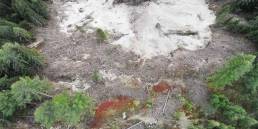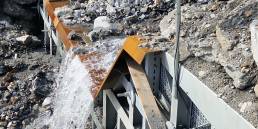
HAPPY MONITORING, a reference for specialist publications in the field of geoinformation
One of the most renowned specialist publishers in German-speaking countries in the field of electrical engineering and information technology publishes specialist journals including “AVN – Allgemeine Vermessungs Nachrichten” – “AVN – General Surveying News”.
Founded in 1889, AVN provides independent, factual, and scientifically sound information on all areas of geodesy and geoinformation. The journal is aimed at professionals in research, industry, government, and engineering, as well as students.

For the August edition, AVN published a study on the accuracy of a GNSS monitoring system for geomonitoring on the Hochvogel. We have already announced our installation on the Hochvogel, the well-known peak in the Allgäu Alps, which lies directly on the border between Bavaria and Tyrol. With an altitude of 2,592 m, it is the highest peak in the area and is therefore subject to heavy erosion. Combined with the unstable geology, this has meant that in recent decades a crack has opened right next to the summit cross and is spreading across the summit. The entire southern flank threatens to collapse into the valley on the Austrian side. Since 2018, the mountain has therefore been subject to intensive metrological monitoring to be able to predict an imminent rockfall as early as possible.

This study presents the innovative GNSS-based monitoring system and evaluates the accuracy that can be achieved with different measurement series. The permanent HAPPY MONITORING system is based on the continuous measurement of RTK coordinates, which are combined in real time into an improved solution by means of an adaptive smoothing algorithm. For each rover, the RTK coordinates are filtered into a selectable time window using a statistical process called “fingerprint” and the remaining measurements are averaged into an accurate solution. We show, with the help of several series of measurements, that the accuracy can thus be significantly improved compared to the accuracy of the individual RTK points. As a function of the baseline length and the solution interval, we investigate not only the relative measurement accuracy of a known deformation but also the absolute measurement accuracy of the distance between two rovers. The movements generated by a cross-slider could be detected with an accuracy of 0.5 mm in position and 1 mm in height for a baseline of 1 km and a solution interval of 24 hours. On a calibration run, also with a baseline of 1 km, the distance between two rovers could be determined with a positional deviation of only 0.1 mm ± 0.2 mm from the theoretical distance. When you read this report, you will see that HAPPY MONITORING provides accurate results even under difficult conditions.
The original technical study is available in German as the official languafe of the magazine. HAPPY MONITORING provides you the translation in English, Portuguese and French at your choise.
Related Posts
28 July 2025
See what matters, before it’s too late
HAPPY MONITORING at 19th Geotechnics Day: sharing insights on natural hazard prevention and smart monitoring in Innsbruck.
26 May 2025
HAPPY MONITORING is Leading the Way at Tiroler Geotechniktag 2025
We’re proud to announce that HAPPY MONITORING will have its own stand at the 19th Tiroler Geotechniktag – Naturgefahren, Austria’s key conference on natural hazard mitigation and…
8 April 2025
Roya International and HAPPY MONITORING: Pioneering Real-Time Infrastructure Safety
We, as HAPPY SURVEY and HAPPY MONITORING, were part of the worldwide geo-community at INTERGEO 2023 in Berlin. That world's largest event and communication platform in the field…



